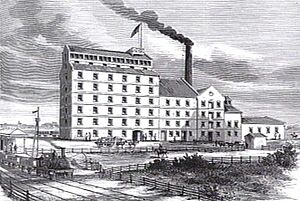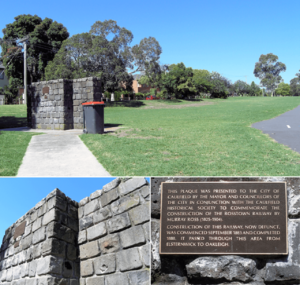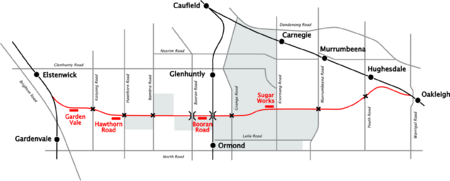Rosstown Railway facts for kids
Quick facts for kids Rosstown |
|
|---|---|
| Overview | |
| Status | Dismantled. Now parkland or under private ownership |
| Connecting lines | Sandringham, Frankston, and Pakenham lines |
| Service | |
| Type | Melbourne suburban service |
| History | |
| Commenced | 1875 |
| Closed | 1916 |
| Technical | |
| Number of tracks | Single track, intended to be double |
| Track gauge | 5 ft 3 in (1,600 mm) |
The Rosstown Railway was a private railway line in the south-eastern suburbs of Melbourne, Australia. It was built in the late 1800s by a man named William Murray Ross. He wanted to use the railway to carry sugar beet to his sugar mill and then transport the refined sugar to the Port of Melbourne.
The railway was planned to run between Elsternwick and Oakleigh. However, the sugar mill never started working. Because of this, the railway line was hardly ever used. It eventually fell apart and was taken down. Today, much of the land where the railway once ran is now parkland or owned by private people.
Contents
The Story of the Rosstown Railway
How It All Started
William Murray Ross was a local businessman and landowner in the 1860s. He is best known for his big plan called the Rosstown Project. This project included a large factory to process sugar beet, a railway line to serve it, and a new housing area.
In 1875, Ross shared his detailed plan with the public. He also started building the sugar mill that same year.
Getting Permission for the Railway
In 1875, Ross also began asking the government for permission to build his railway. He wanted it to run from Elsternwick railway station to his sugar mill. This station was part of an existing railway system.
His first plan was rejected. So, in 1876, Ross submitted a new idea. This time, the railway would go past his mill all the way to Oakleigh. Oakleigh did not have a railway connection to Melbourne at that time.
A new railway line to Gippsland was being planned. This was a big political issue with many important people involved. The Gippsland line was first meant to start from Elsternwick. But the existing railway company wanted too much money for other trains to use its tracks. So, it was decided the Gippsland railway would connect to a new station built at Oakleigh.
Connecting Ross's railway to these new lines seemed like a good idea. However, the government was careful about allowing another private railway. This was because of their difficult talks with the existing railway company. So, Ross's plan did not get approved right away.
In 1877, Graham Berry became the leader of Victoria. He made John Woods, who supported Ross, the Minister of Railways. In July 1877, a group of politicians visited Ross's sugar factory. They were impressed with how much work had been done.
Because of this, a special committee was set up to look into the Rosstown Railway plan. On August 8, 1877, they released a very positive report. But many government members, including John Woods, were still worried about private railways. This led to over a year of no action.
Finally, on October 16, 1878, the law allowing the Rosstown Railway to be built was passed. It received official approval on November 14. One rule of the law was that the railway had to be finished within five years. On April 2, 1879, the railway from Oakleigh to Gippsland was opened.
Building the Railway Line
By the time the "Rosstown Junction Railway Act" was passed, Ross was already in debt. He found it hard to get enough money to start building the railway. He managed to get six thousand pounds from a bank. Work finally began in 1883, with the first rails laid in November.
Ross used cheaper iron rails from the Victorian Railways. The Railways also helped by building the connections at Elsternwick and Oakleigh. However, Ross had a disagreement with the Railways about crossing the Mordialloc line. Ross wanted a simple flat crossing, but the Victorian Railways said no.
The five-year deadline was only weeks away. Ross had no time to argue. Construction became very rushed, and many shortcuts were taken. Wooden sleepers, which support the rails, were laid on bare earth. They were placed 12 feet (about 3.6 meters) apart, much wider than the usual 2 or 3 feet (about 0.6 to 0.9 meters). In some places, the sleepers had sunk into the ground and did not even touch the rails. When sleepers ran out, posts from nearby fences were used.
The last part of the track was laid after sunset on the very last day of the five-year period in 1883. Ross had permission to leave out the difficult Mordialloc line crossing for now. So, the construction was technically finished on time. The Mordialloc line had opened two years earlier, with a temporary crossing over the Rosstown railway.
A newspaper article from 1884 described the railway as "remarkably incomplete." It said there was no ballast (stones under the tracks) and the sleepers were old. The rails were old ones from the government lines. The railway was built on a slight earth mound, which was too narrow in many places. The article also noted that the sleepers were too far apart and the rails were not properly fastened. It concluded that almost everything would need to be rebuilt for the line to be used.
Rebuilding the Line
In early 1884, Ross thought about extending his railway to Port Phillip Bay at Elwood and then north to St Kilda. This idea had local support but did not go far. Ross then asked for another five-year extension to his building rights. This was approved on December 12, 1884.
Ross was already deeply in debt. He offered to sell the railway to the Victorian Railways. When they said no, he lowered the price several times. The Victorian Railways wanted the state to own all railways. A bill was put forward to buy Ross's line. But it was stopped because buying a poorly built, unused railway was seen as too risky.
By the end of 1885, two years into his extension, Ross knew he had to build the line properly. He started rebuilding when he could, but it was clear he would not meet the new deadline. In 1886, a deal was made about the Mordialloc line crossing. The Mordialloc line would be raised to cross the Rosstown Line on a bridge. Ross had to pay for the work, and the Victorian Railways would pay him back two-thirds of the cost.
Ross first planned a simple wooden bridge to save money. But the Railways did not accept this. An iron bridge was designed and built by an engineering company. The whole project cost £5,850. The single-track bridge opened on June 17, 1887, and was made wider for two tracks in 1888.
On November 17, 1888, the last day of the five-year extension, the Rosstown Railway was still not finished. Ross wrote to the Victorian Railways, saying the line would be ready in about three months.
Trains on the Line
Even though the Rosstown Railway is known as a big failure, trains did use the tracks sometimes. Trains carrying construction materials and ballast (stones for the tracks) were often on the line in the late 1880s and early 1890s. These trains were pulled by Victorian Railways locomotives that Ross had rented. The largest was a Y-class locomotive. Ross had planned to build his own trains, but this never happened.
As for passenger trains, a book by the Rosstown Historical Research Group, Return to Rosstown, shares an interesting story:
- Ross knew about the deadline for his railway. He later claimed that on November 14, 1888, he rented two carriages and a locomotive from the Victorian Railways.
- He said he ran a train with passengers, including a politician named Thomas Bent, and two lawyers.
- Ross claimed the train went from Elsternwick to Oakleigh, stopped for refreshments, and then returned to Grange Road. There, the group got off and went to Ross's house for dinner.
- Ross used this story as proof that the line was built well enough for a heavy engine and two loaded carriages.
It is strange that no Melbourne newspapers mentioned this train ride. The local Brighton Southern Cross newspaper usually reported fully on Rosstown Railway work. One reason for the lack of news might have been Ross's wish to avoid attention from the Board of Land and Works. This train ride was probably against the rules. Still, there had been a lot of movement of men and materials on the line since September, so the Board might have overlooked it.
Ross's own story of this "first train" for passengers seems more accurate than other versions. One detailed version by Isaac Selby in 1924 linked the train ride to Ross's second wedding. However, this idea was passed down by word of mouth and is wrong. Ross's wedding was in February 1889. Newspapers reporting on the wedding made no mention of train travel.
As far as we know, the last train pulled by a locomotive was a ballast train on March 21, 1891.
The Railway's Decline
Ross faced big financial penalties for missing deadlines, but these were never enforced. Some historians believe this was because of a land boom in Melbourne in the 1880s. The value of land near a railway line was expected to increase greatly, which was exciting for many people. Ross still hoped to finish his Rosstown Project. His mill had been unused for years, full of equipment that was never put to work.
During the 1890s, Ross kept trying to get out of debt. He set up companies to hide his debts and get more credit, but none of them worked. He tried several times to sell the Rosstown Railway to the Victorian Railways. But a depression followed the land boom. No one saw a future for a railway that crossed empty fields and would not have much traffic.
Ross owned the line until he died in 1904. His failed sugar beet mill, known for many years as "Ross' Folly," was torn down in 1908.
The End of the Line
The National Bank of Australasia tried to sell the railway line at auction in 1906. They wanted £20,000, but no one bought it. Thomas Bent offered £17,000, but then changed his mind. In 1911, a local community group talked to the National Bank. They hoped to buy and reopen the line with support from the City of Caulfield. A study estimated that repairing and reopening the line would cost more than £60,000. Since they could not raise that much money, the idea was given up.
Five years later, in December 1916, the Caulfield Council asked the government to cancel the laws for the Rosstown Junction Railway. This was done, and the Rosstown Railway legally no longer existed. The rails were pulled up and sold to another railway company in Tasmania. The National Bank started selling off the land in 1910, but the last part was not sold until 1946. The Caulfield Council bought some of the railway land. They turned parts of it into roads and what is now Ormond Park.
Today's Rosstown Railway Trail
You can still trace much of the old railway line today. It runs through Council parks and roads that were built where the tracks once lay. In 1983, a plaque was put up in South Reserve at Marara Road. This marked 100 years since the railway's construction began. This is one of the clearest places to see where the line used to be.
The Glen Eira Council now manages and promotes the Rosstown Railway Heritage Trail. It is a popular route for cycling and historical walks.
Railway Map




